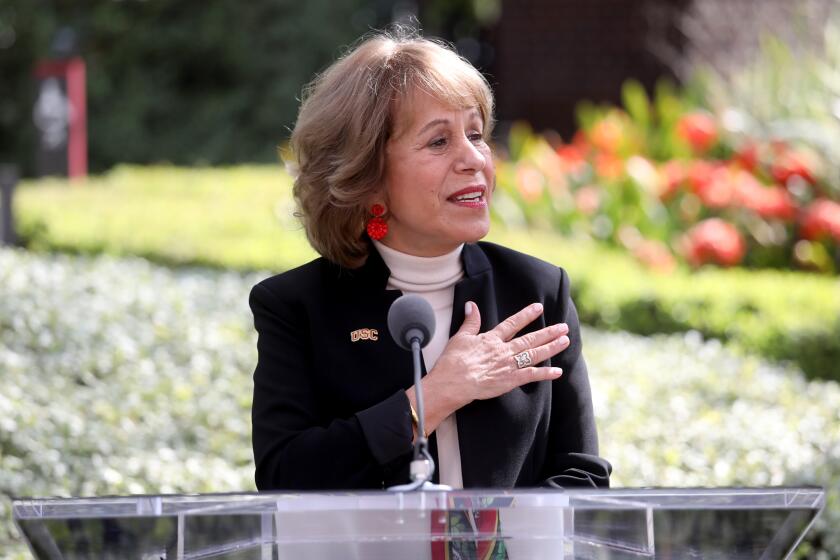Students on a Mission for Safer Campuses
Sometimes, you can learn as much from failure as you can from success.
Just ask the El Sereno Middle School students who have spent the past year trying to convene a citywide task force on school safety.
“Closed doors, brick walls, roadblocks.” That’s what they’ve run into time after time, said their teacher Ernie Delgado. “It’s been very, very frustrating. It’s hard for them to understand why everything is so difficult. I’m trying to get them to realize that change doesn’t happen overnight.”
The students’ idea seemed simple enough: Gather student leaders from each of Los Angeles’ middle and high schools at a safety summit to identify campus problems and recommend solutions to the school board.
“We wanted to make it citywide, so we could speak in a unified voice about something that matters to students everywhere,” said eighth-grader Mariella Saba. “But it seems like some people just don’t want to hear us.”
“Yeah,” agreed seventh-grader Ruth Luna. “Like they don’t take us seriously. They treat us like a bunch of little kids.”
*
They may be only 12 and 13, but Delgado’s social studies students have seen too much and come too far to be intimidated now. “We’re tired of having to be afraid on the streets and at school, and we’re tired of not being listened to,” said Carolina Chau, a seventh-grader.
Their activism began with a project in Delgado’s social studies class. “They were talking about how dangerous their neighborhood is, how a day doesn’t go by that they don’t hear gunfire,” said Delgado, who himself once lived in the El Sereno neighborhood, near downtown.
“I thought if they could do a project like this, it would empower the students to understand that even though they’re kids, they can work within the system to make a difference.”
Their first project, in 1999, was a gun buy-back campaign. They sold candy door-to-door to raise money to pay gun owners a bounty on every gun they turned in. The idea was to get guns out of gang members’ hands. They tasted success, raising more than $3,000--enough to purchase 34 guns. But they also sampled failure. The LAPD required everyone turning in guns to identify themselves, and that kept most gang members away. And the students’ plan to expand the campaign fell apart when local politicians failed to deliver on promises to help them secure a federal grant.
But that did not deter them. They made the rounds of civic leaders--Councilman Nick Pacheco, Police Chief Bernard Parks, school board member David Tokofsky, Mayor Richard Riordan--pitching their task force plan.
“They all thought it was a good idea in the meetings,” said seventh-grader Fallon Flores. “They’d say, ‘Yeah, yeah’ . . . But then no one would return our calls.”
The School Board required them to seek approval from each of the district’s 11 regions. Most officials were receptive, Mariella said. “They’d give us ideas and try to help us out.” But others were wary, and some were downright condescending.
“They told us maybe we should do this in our community first,” said Carolina. “They were patronizing us. You could tell in the sound of their voice. Then we really knew what we were up against.”
*
There are just a few weeks left in this school year now, and the task force plan has been put away until September. “But we’re not letting it go,” declared Carolina. “That would be wasting everything we’ve learned.”
Some of those lessons strengthened their resolve. In meetings with the city’s movers and shakers, they learned not to be intimidated, as they parried objections and fielded questions. They learned that the devil can be in the details, and faulty logistics can derail the best-laid plan. They learned to take the promise of a politician with the proverbial grain of salt.
Other lessons were bitter pills to swallow. They learned that not every neighborhood shares the perception of danger that they see in their streets. They learned that achieving consensus is harder than it looks in history books.
“Some communities, they just want to isolate themselves. They don’t want to look at the kind of problems that we face,” said seventh-grader Yaneth Escobar. And too many grown-ups “think they know everything,” she said.
“They’re speaking for the children, saying, ‘We don’t have a [safety] problem; we don’t need your task force here.’ But what do the children think? That’s what we want to know. We need to hear from them, whether they feel safe at school.”
So the mission has become not just improving school safety, but empowering other kids. “We learned that people look down on us because we’re kids,” said Fallon. “We have to prove ourselves by succeeding at something they don’t think we can do.
“Now, adults are making most of the decisions. But if we can make this work, we can change their view of what it means to be a kid.”
*
Sandy Banks’ column runs on Tuesdays and Sundays. She’s at sandy.banks@latimes.com.
More to Read
Start your day right
Sign up for Essential California for news, features and recommendations from the L.A. Times and beyond in your inbox six days a week.
You may occasionally receive promotional content from the Los Angeles Times.






